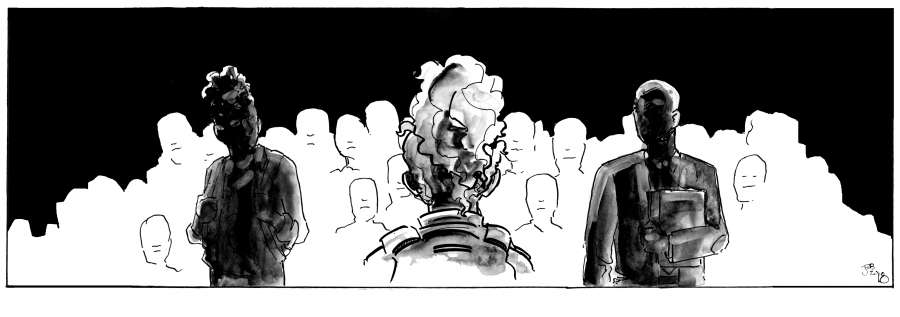The movie “Black Panther” is generating enormous attention and record-breaking ticket sales. But while African-American advancement experiences a breakthrough in film, it still lags acutely in higher education.
Last month, university administrators decided which high school graduates will become college students. On March 1, roughly 51,000 high school students found out whether they’ve been admitted to UT-Austin. Last year, 64 percent of all applicants were denied admission: 32,413 students.
As a professor at UT-Austin, I’m struck every semester by a glaring deficit in my classrooms.
The courses I design should be valuable to many students. This semester I’m teaching courses titled “Biology, Behavior and Injustice” and “History of Money and Corruption.” The combined enrollment in these courses is 103. Yet only one of those students is African-American. Less than 1 percent. Last semester I taught two courses that train students to become science and math teachers. How many of the students were African American? None. Last year, I also taught a course titled: “Race, Science and Racism.” There were no black students in that class either.
In Texas, 12.6 percent of the population is black. If they were fairly represented in my classrooms, then for every 100 students, I’d expect to have ten or fifteen African-Americans. That would be fair. But at UT-Austin, only 4 percent of undergraduates are black.
We should urgently improve the educational opportunities offered to young black students. In September 1950, the first black student enrolled at UT-Austin after a grueling legal struggle. Yet 67 years later, barely 4 percent of the undergraduate students at UT-Austin are African-Americans. To me, this is a shamefully low and unacceptable number.
Some may rush to counter that no admissions system can be based on racial quotas, especially considering that UT-Austin has two procedures for admissions that already aim to increase racial diversity on campus. Students who rank in the top 7 percent of their schools are automatically admitted. However, 80 percent of the remaining applicants are excluded.
To be sure, there are ongoing discussions about how to improve the “campus climate” by removing or contextualizing historical statues and perhaps also the names of buildings. Still, I’m exasperated that enrollments of black students continue to be so low.
In fall 2017, there were 40,492 undergraduates at UT-Austin. If 12.6 percent of them were African-American (matching the Texas population) then there would be at least 5,102 black students on campus. Instead, there were only 1,632. That’s a grossly low number, given that 3.5 million Texans are African-Americans.
Meanwhile, from 2000 until 2010, the population in Austin grew by more than 20 percent. At the same time, however, the relative number of black people in Austin decreased by 5.4 percent. Among the ten fastest growing cities in the United States, Austin was the only one in which the black population decreased during that decade — a great embarrassment.
From 2010 to 2016, the percentage of black people in Austin fell even further, from 8.4 to 7.6 percent.
In 2016, the median household income in Texas was $56,565. One might thus imagine that most students at UT-Austin come from such households. But that isn’t the case. Instead, most students here come from families that are more than twice as wealthy. A recent study by the Equality of Opportunity Project on economic diversity revealed that the median income of students’ families at UT-Austin was $123,900. I was surprised to learn that 56 percent of our students come from the top 20 percent of wealthiest families.
Therefore, UT’s admissions policies create a kind of economic segregation.
Whereas barely 4 percent of our undergraduates are African-American, 38 percent of our students come from the top 10 percent richest families in Texas. This is not what should transpire at a public university.
Administrators at UT-Austin use a sophisticated formula to determine which high school applicants receive offers of admission. The formula is complex and has gradually changed, but its results are clear. Wealthy families benefit disproportionately.
One of the worst side effects of this trend is that it perpetuates the economic marginalization of African-American students. Most of them are denied admission here because their rankings in schools are not high, which results from weaknesses in the schools they attend. Many students’ parents lacked the resources to send them to better schools. And of course, many parents lacked those resources themselves because they didn’t benefit from higher education. It’s a vicious cycle.
A disproportionate number of black Texans live in poverty. Of the four million people in Texas living in low-income households, more than 21 percent are black. They struggle to survive on a yearly income of less than $24,250 for a family of four. Pell grants help some low-income students pay for college, but students can’t benefit if they’re denied admission in the first place.
In order to empower many Texans to break the cycle of poverty, UT-Austin should enroll more students who are economically disadvantaged. Otherwise, as the city of Austin continues to grow, its percentage of African-Americans declines. Low family incomes shouldn’t obstruct young Texans’ chance to succeed. UT would really benefit from more diversity in our classrooms.
Martinez is a professor in the Department of History and a Public Voices Fellow with The OpEd Project.
















